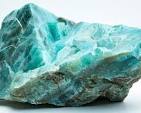
Amazonite: The Calming Warrior Stone of Raw Beauty
Amazonite is a gem of duality — as tranquil as a gentle stream and yet as bold as ancient shields. With its captivating shades of turquoise-green and faint white marbling, this raw crystal beckons both the aesthetically inclined and the energetically attuned. Its soothing presence and opaque vibrancy make it a favourite in raw crystal jewellery, particularly when set in its unpolished, natural form.

Geological Profile: Composition, Structure, and Colour
Amazonite is a green variety of microcline feldspar, a potassium aluminium silicate with a hardness of 6–6.5 on the Mohs scale. Its unique hue is attributed to the presence of trace amounts of lead and water within its crystal lattice. While often confused with jade or turquoise due to its colour, Amazonite is chemically and structurally distinct.
This mineral typically forms in granite pegmatites, and it’s found in a range of locations, including:
-
Colorado and Virginia, USA
-
Russia’s Ilmen Mountains
-
Madagascar
-
Brazil
-
China
Its crystal habit is usually tabular or blocky, with a vitreous lustre when polished. However, in its raw state, Amazonite exudes an earthy opaqueness that evokes the grounded energy of the natural world.
Energetic Meaning and Healing Properties
Often referred to as the “Stone of Courage and Truth,” Amazonite is beloved for its powerful yet gentle energy. It is associated with both the Heart and Throat Chakras, making it an ideal companion for those seeking:
-
Emotional clarity and communication
-
Courage to speak one’s truth
-
Rebalancing of feminine and masculine energies
-
Calming of the nervous system and emotional trauma
In energy healing circles, Amazonite is often placed on the chest or throat during meditation to facilitate self-expression and release energetic blockages. Its soft yet steady resonance helps to dissolve fear, ease frustration, and calm emotional turbulence, like a river smoothing over jagged rocks.
Its colour alone — a soothing blend of sea-green and sky-blue — seems to cool the heat of the heart and mind. Many intuitive practitioners describe its presence as “mothering yet resolute,” and it’s frequently used in crystal layouts aimed at restoring inner peace and boundary clarity.
Unique Natural Form and Collectibility
In its natural, unpolished form, Amazonite displays remarkable striations, fractures, and colour banding. Each raw piece often looks like a frozen wave of oceanic energy — layered, imperfect, and deeply evocative. The white streaks or inclusions of quartz or feldspar only add to its visual and energetic depth.
Collectors of mineral specimens are particularly drawn to Amazonite clusters, especially those that occur alongside smoky quartz or albite. In some rare localities, such as the Pikes Peak region of Colorado, Amazonite forms high-quality crystal clusters that are sought after by both metaphysical practitioners and geological enthusiasts.
Amazonite is not considered among the rarest of minerals, but high-grade, naturally vibrant specimens can command significant attention in the raw crystal market — especially when left unpolished for use in crystal specimen rings or mineral specimen necklaces.
Amazonite vs. Other Green-Blue Crystals
Amazonite is often visually compared to turquoise, jade, and chrysoprase, but each carries its own distinct frequency and geological background.
-
Turquoise is a copper aluminium phosphate and is usually more opaque with a waxy lustre. It tends to embody more protective, ancestral energies.
-
Jade — especially jadeite — is denser and traditionally associated with prosperity and the afterlife in East Asian cultures.
-
Chrysoprase, a form of chalcedony, radiates a more vibrant apple-green hue and is typically linked to joy and emotional detox.
What sets Amazonite apart is its unique ability to bridge emotional openness with articulate strength. While jade may guard and chrysoprase uplift, Amazonite calms while encouraging expression — a rare energetic blend that is both grounding and inspiring.
Use in Jewellery: Raw Elegance in Everyday Form
The raw beauty of Amazonite finds a natural home in mineral specimen jewellery, where the stone’s untouched surface allows its vibrational field to remain intact. In its unpolished form, the soft undulations and earthy textures bring authenticity to handmade gemstone rings and crystal specimen necklaces.
Its soft Mohs rating does require careful handling, making it better suited to pendants or earrings rather than rings exposed to daily wear. However, when wrapped or mounted with skill, Amazonite adds a distinct signature of strength and serenity.
Those who wear Amazonite often describe it as a “companion stone” — one that feels deeply personal and protective, almost talismanic. For sensitive souls, artists, and those finding their voice, this raw crystal becomes not only an adornment but a daily affirmation.

Ancient Associations and Subtle Legends
Though Amazonite does not have the extensive mythological history of stones like sapphire or emerald, its name is steeped in intrigue. It is believed to be named after the Amazon River, although no Amazonite has ever been found in that region. Some legends connect it to the fierce Amazonian warrior women, suggesting that the stone embodies feminine strength and fearless truth.
In ancient Egypt, Amazonite was used in amulets and jewellery, including the famous scarab rings. It was carved and set into protective talismans and is even thought to have adorned the tomb of Tutankhamun, offering guidance in the afterlife.
A Note on Raw Beauty
In a world where polished perfection is often prized, the unrefined soul of Amazonite reminds us that nature’s irregularities are not flaws, but signatures of truth. It resonates with the ethos of mineral specimen jewellery, where form follows frequency, and every piece carries a whisper from the Earth.
At Oryssia, we honour stones like Amazonite not by transforming them, but by allowing them to speak in their raw, resonant voice. It is not simply about beauty — it’s about connection, presence, and intention.